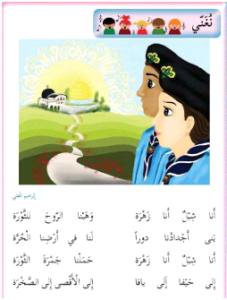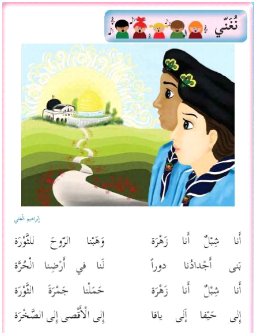The PA textbooks taught in UNRWA schools (grades 1-10) in Judea, Samaria, East Jerusalem and the Gaza Strip present the city of Haifa, which is located within Israel’s pre-1967 territories, as a Palestinian city:
A lesson titled “Cities of Palestine” mentions the cities of Jerusalem, Gaza, Khan Yunis, Hebron, Ramallah, Nablus, Tulkarm, Jenin, and also Jaffa and Haifa (National Education, Grade 2, Part 1 (2015) p. 22).
Another book features a text in which a teacher asks the students to do research on Palestinian cities, and one of the students says that she will ask her grandmother to tell her about the city of Haifa. In that same book a question reads: “We will mention the names of the Palestinian cities that appeared in the text [Gaza, Hebron, Jericho – and Haifa]” (Our Beautiful Language, Grade 2, Part 1 (2016) pp. 114, 115, respectively; (2020) pp. 118, 119). Haifa also appears among the Palestinian cities in another assignment (Mathematics, Grade 2, Part 1 (2016) p. 91)
Both Gaza and Haifa are said to be port cities in Palestine (Geography of the Arab Homeland, Grade 9 (2015) p. 82, and see the assignment on p. 83: “An outline map of the Arab homeland will be distributed to the students upon which I will write the names of the Arab States and mark the ports of Haifa, Aden, Basra, Alexandria and Damam.”)
A lesson titled “Palestinian Cities” discusses in some detail, under the title “the Most Important Palestinian Cities”, a number of cities located in pre-1967 Israel: Haifa, Jaffa, Nazareth, Safed and Beer Sheba. In no place does this piece mention that these cities are now found inside Israeli territory (Geography of Palestine, Grade 7 (2014) pp. 81-85). On the contrary, an assignment on p. 86 specifies: “I will draw a map of Palestine and put on it the most important cities.”
In the following assignment the student is required to put the name of a city – the Israeli city of Haifa in this case – in a sentence: “3. The city of …[Haifa]… is one of the Palestinian coastal cities.” (National and Life Education, Grade 2, Part 1 (2017) p. 81)
Caesarea, Haifa and Acre are mentioned among Palestine’s touristic sites (National Education, Grade 2, Part 2 (2015) p. 61)
The Palestinian city of Haifa was occupied in 1948, its Arab residents have left it and yearn to come back:
“-When was the city of Haifa occupied? -Mention some Palestinian cities that were occupied in 1948.” (Teacher’s Guide, Arabic Language – Academic Path, Grade 10 (2018) p. 64)
And in response to a question about Palestinian cities that were “occupied by the enemy” in that same year: “3. Haifa, Jaffa, Ashkelon, Acre.” (Teacher’s Guide, Arabic Language, Grade 8 (2018) p. 212)
“We left Haifa with the intention to return and God is the [only] one who knows what will become of us.” (Reading and Texts, Grade 10, Part 1 (2015) p. 39)
“The teacher will tell a short story about our homeland Palestine: ‘My grandfather used to live in a nice village in [the vicinity of] Haifa. He worked in agriculture, loved the land and guarded it. On one sad day foreign faces came in order to drive my grandfather out of his land, burn the crop and force him to emigrate to distant lands’.” (Teacher’s Guide, Our Beautiful Language, Grade 2, Part 2 [2016] p. 53; Our Beautiful Language, Grade 2 (2018) p. 124)
A story titled “A homeland that resides within us”: “Yasser and his sister Abir agreed to participate in a journalistic writing contest by writing an essay about Palestine. Abir: ‘What will we write in the essay?’ Yasser: ‘We will write about the homeland that resides within us [while] we do not reside there.’ Abir: ‘And how would we write about a homeland that we cannot reach?’ Yasser: ‘We will ask grandfather and grandmother and the [other] elder people about Acre, Haifa, Jaffa, Safed and other places.’ Abir: ‘And we will not forget to express our dream and right to return to our homeland and live there’.” (Our Beautiful Language, Grade 2, Part 2 (2016) p. 6; (2020) p. 8)
One of the sentences within an exercise following that story: “Yasser’s grandfather was living in the city of Haifa.” (Our Beautiful Language, Grade 2, Part 2 (2016) p. 8; (2020) p. 9)
The Palestinian city of Haifa must be liberated:

“B. Haifa is awaiting its liberation.” (Teacher’s Guide, Our Beautiful Language, Grade 4 (2018) p. 204)
The supposed liberators are the youths of the Palestinian Al-Fatah organization, as said in the following hymn of the organization’s youth movement: “I am a lion cub; I am a flower; we gave [our] soul to the revolution Our forefathers built for us houses in our free country [in the future] I am a lion cub; I am a flower; we carried the revolution’s ember To Haifa, to Jaffa, to Al-Aqsa [Mosque], to the [Dome of the] Rock”
(Our Beautiful Language, Grade 2, Part 1 (2016) p. 42; (2020) p. 44)
The notion of the return of the refugees’ descendants to Haifa while it is still under Israeli rule is presented as sheer lunacy, which makes us understand that it should take place after the elimination of Israel:
In a story appearing in a tenth grade Arabic Language textbook, the hero is arrested and sent back from Haifa to the West Bank by the Israeli police following his attempt to visit his father’s house in the city years after the latter’s departure in 1948. The ending sentence in the story, in which the hero agrees with the policemen who call him ‘crazy’, is the subject of the following question and answer in the corresponding teacher’s guide: “6. Why did the writer describe himself as crazy at the end of the story? -Because the one, who is expelled from his homeland and is later content to return to it as a guest with the robbers who had seized it, is really crazy.” (Teacher’s Guide, Arabic Language – Academic Path, Grade 10 (2018) p. 199)









